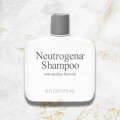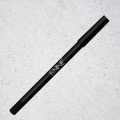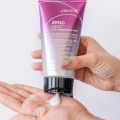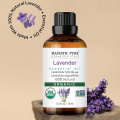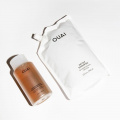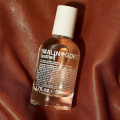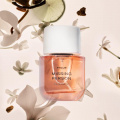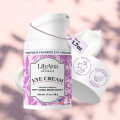Coconut Oil for Tanning: Benefits And Ways to Use for Glowing Skin
Coconut oil, a widely used skincare product, is equally effective for tanning as well as removing a tan. Read on!

With global warming on the rise, summers have become unbearably scorching. Gone are the days when tanned skin was only seen after a beach vacation. Today, you are exposed to ultraviolet (UV) radiation and tanning even during your day-to-day activities. Tanning is much more than the different shades of brown — it is the exposure of your skin to the potentially harmful UV rays that can cause anything from early aging to skin cancer. Thus, having an all-natural cost-effective home remedy to protect and remove tanning would be amazing — this is where coconut oil for tanning comes into play.
From understanding the science of tanning to discovering the de-tanning properties of coconut oil, we will delve into practical tips and methods for making the most of this natural remedy. With the power of coconut oil, bid adieu to uneven skin tone and say hello to a refreshed, radiant complexion. Wait, there’s more — if you’ve been trying to get a subtle tanned look with various tanning oils and sprays creams but in vain, coconut oil can help you with that, too! Yes, this remarkable oil is a boon for DIY skincare remedies lovers — from fading tan lines to fighting wrinkles to making the skin get a bronzed look, it does it all (and that too effortlessly).
Coconut Oil for Tanning: How to Use It to Get a Sun-kissed Look?
Being a multipurpose skincare product, coconut oil can help you get a gorgeous sun-tanned look. So if you have coconut oil with you, you won’t have to worry about skincare woes. If you want to get a subtle and natural tanning look, it is an apt choice.
Although coconut oil cannot directly protect you from sunburns, it might act as a good alternative to synthetic tanning oils and be a good choice to keep your skin hydrated and give yourself mild protection from harmful sun rays. But it’s important to not use it alone, but along with a SPF for tanning.
Below is a step-by-step guide on how to use coconut oil for sun tanning:
Take a few drops of coconut oil, rub it onto your palms, and massage it all over your body. You can pour coconut oil into a pump bottle if you are going to the beach and want to use it more than once.
If you are heading to the beach, make sure to wear your hat and sunglasses to safeguard yourself from the harmful effects of the sun's rays.
Soak in the sun to get a beautiful sun-kissed tan, but make sure not to be in the sunlight for more than 20 minutes, or else it might harm your skin.
Is Tanning with Coconut Oil Safe?
When used appropriately, coconut oil tanning can be safe, but it's crucial to recognize its limitations and take the necessary safety measures.
The benefits of coconut oil for sun tan are as follows:
Tan Enhancement
You can improve and deepen your tan by applying coconut oil to your skin before stepping out in the sun. It is an amazing hack for soaking the sun better, resulting in a more even and durable tan.
Tan Extender
Coconut oil is useful for preserving and extending tans after tanning. Its moisturizing qualities keep the skin from drying out, which could hasten the fading of the tan.
What Are the Skincare Benefits of Coconut Oil?
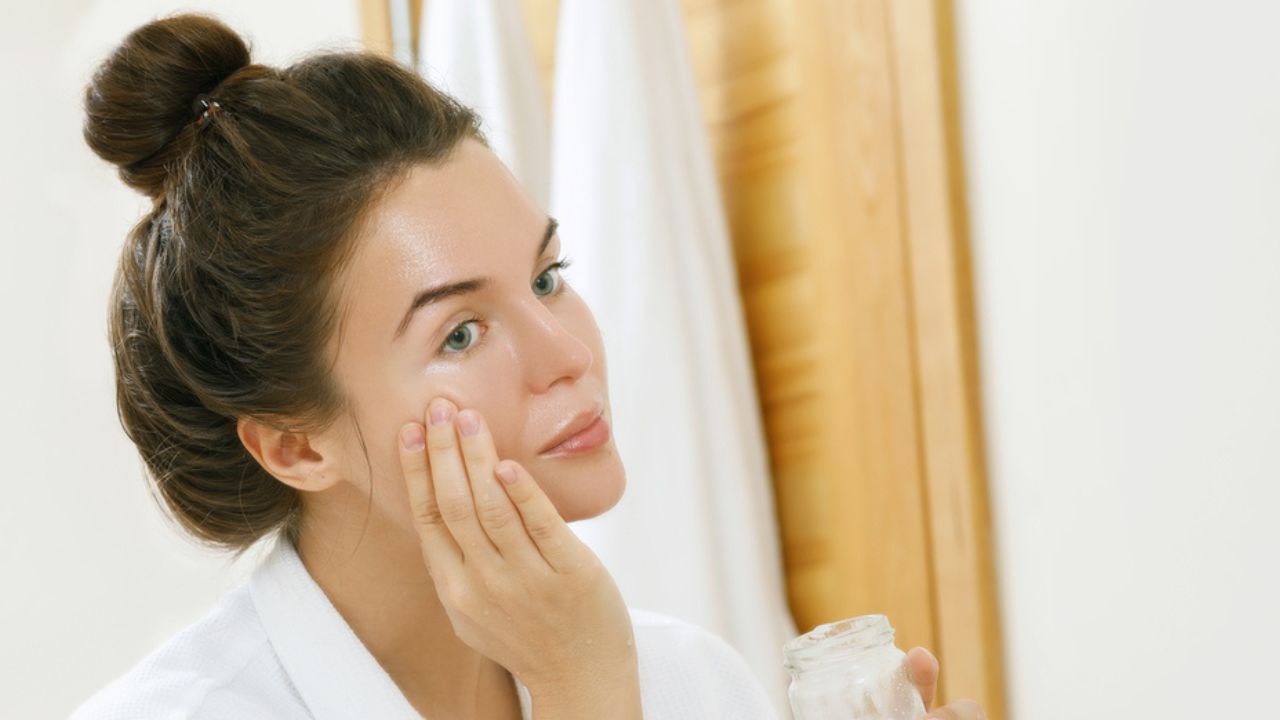
After learning various ways to use coconut oil for tanning, let's examine the benefits of using it to remove a tan.
1. Natural Skin Protection
Antioxidants found in coconut oil help repair damaged skin cells. It eases sunburns, reduces inflammation, and speeds up skin healing after too much sun exposure. The anti-inflammatory properties of coconut oil help to calm and soothe the skin, reducing irritation and redness caused by tanning or sunburn (1).
12. It Acts As a Natural Sunscreen
When applied to the skin, coconut oil's low SPF (around 1-3) offers some protection from UV ray damage. It functions as a natural sunscreen by lowering the possibility of sunburn and additional tanning (2).
3. It Boosts Skin Moisturization
Coconut oil is a powerful moisturizer that helps to hydrate the skin. Tanning usually dries out the skin and makes it rough. Thorough moisturization keeps the skin soft and supple and prevents dryness, which is essential for tanned skin (3).
4. It Boosts Skin Repair
Coconut oil contains antioxidants that aid in repairing damaged skin cells. It helps soothe sunburns, reduces redness, and promotes skin healing after excessive sun exposure (1).
5. It Has Anti-Aging Effects
Coconut oil's high antioxidant content, such as vitamin E, aids in the fight against free radicals, which contribute to premature aging. It aids in the reduction of fine lines and wrinkles associated with sun exposure, keeping the skin youthful and vibrant (1).
6. It Helps Fade Tan Lines
Regularly applying coconut oil to tan lines can help fade them over time, making the skin appear more even-toned (1).
Coconut Oil for Tan Removal: Does It Work?
The best thing about coconut oil is that there's no limit to its benefits and uses — it can be used on hair, skin, and for cooking. Plus, even in the world of skincare, it can help with both tan removal and achieving a tanned look. Below we have explained in detail the various skincare benefits of using coconut oil for removing tan and getting glowing skin.
Ways to Use Coconut Oil to Get Rid of Tanning: 10 DIY Remedies for Tan Removal
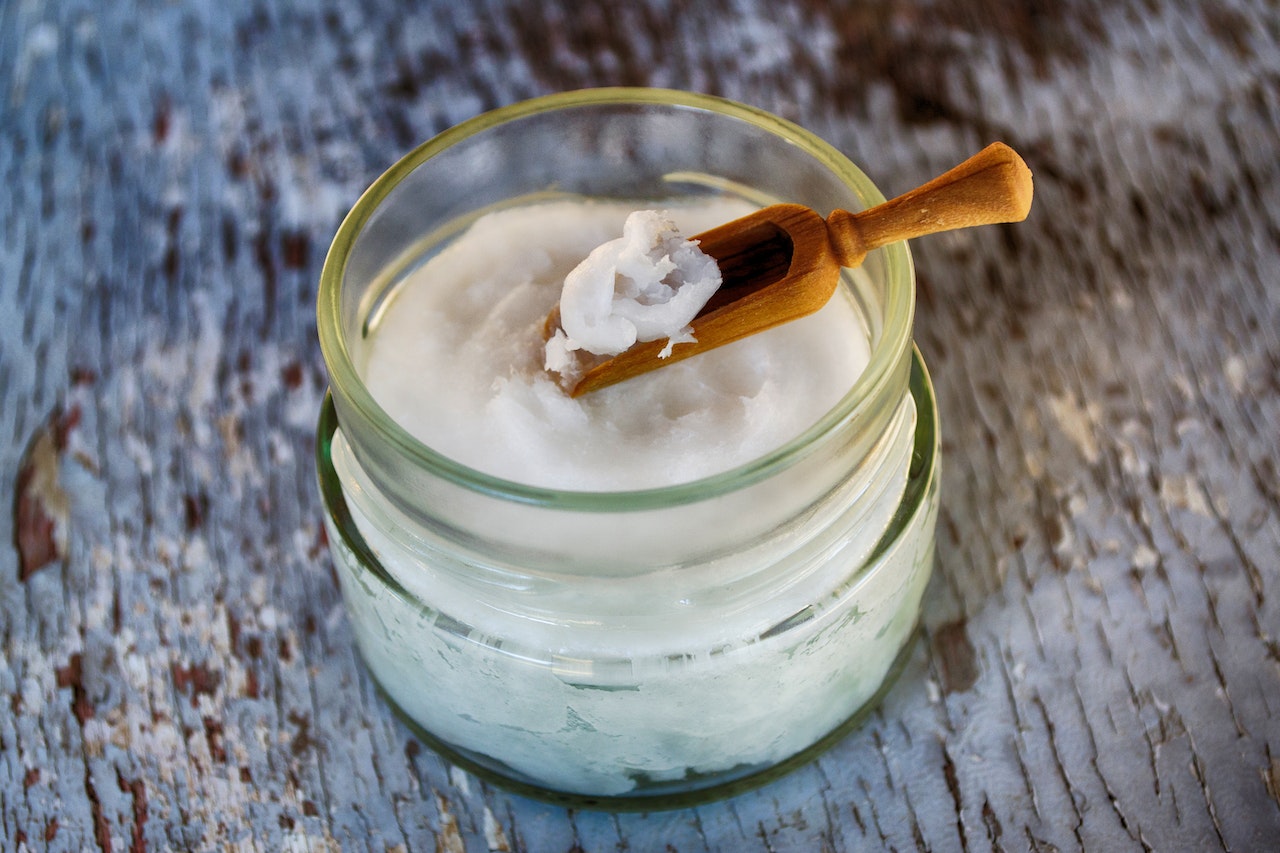
Removing tan with coconut oil requires meticulous planning and patience. This oil, derived from the fleshy insides of the coconut, is rich in fatty acids, antioxidants, lauric acid, and vitamins (1). Coconut oil for tanning can be used alone or in conjunction with a few other skin-friendly natural ingredients. With minimal documented side effects, embrace the sun-protective benefits of coconut oil and say goodbye to commercial de-tanning creams.
Here are a few effective ways to use coconut oil for tan removal:
1. Coconut Oil Massage
Ingredients
- A few drops of cold-pressed coconut oil
Instructions
- Put a little warm coconut oil in your hands.
- For 5 to 10 minutes, use circular motions to massage the oil into the tanned areas gently.
- Allow the oil to absorb into the skin by leaving it on for an additional 10 minutes.
- Use lukewarm water and a mild soap-free cleanser to rinse.
- For best results, repeat daily.
2. Coconut Oil And Lemon Juice
Ingredients
- 1 tablespoon of coconut oil
- 4-5 drops of freshly squeezed lemon juice
Instructions
- Combine the coconut oil and lemon juice in a small bowl.
- Using your fingertips, apply the mixture to the tanned areas.
- Keep it on your skin for fifteen minutes.
- Use water to wash it.
- Repeat two or three times per week to see results.
Benefits
Lemon is a powerhouse of citric acid or vitamin C. It is famous for its skin-lightening, sun-protective, and de-pigmentation abilities. In addition, the antioxidants help in removing the fine signs of aging (2).
3. Coconut Oil And Turmeric
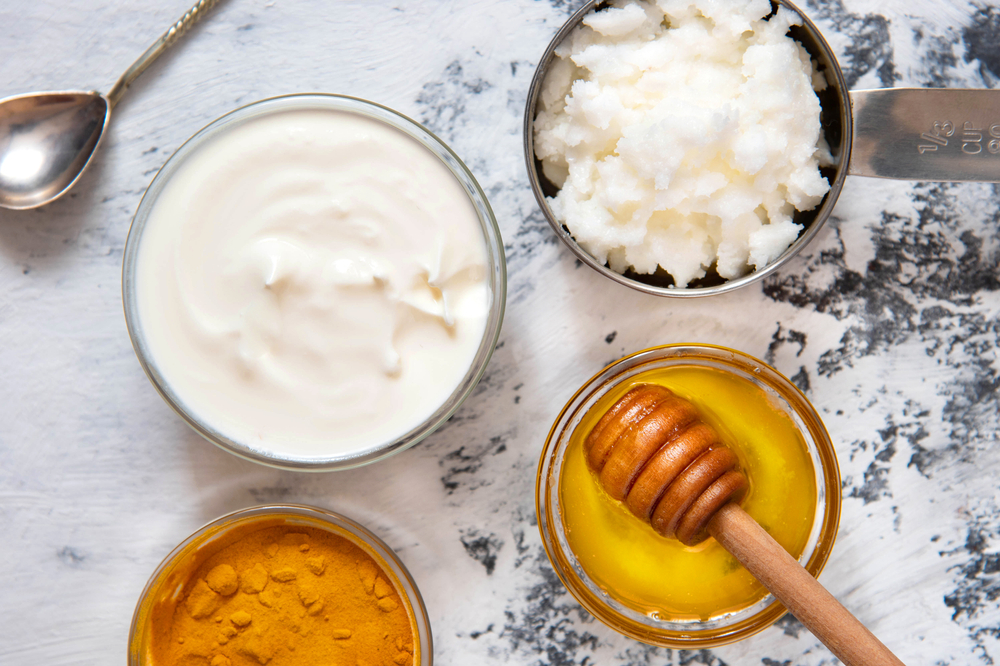
Ingredients
- 1 tablespoon of coconut oil
- A pinch of turmeric powder
Instructions
- Make a paste in a bowl by combining the coconut oil and turmeric powder.
- The paste should be applied to the tan lines.
- Leave it on for 20 minutes.
- Rinse thoroughly with lukewarm water.
- For best results, repeat this method 2-3 times per week.
Benefits
Turmeric has skin-lightening, anti-inflammatory, and antibacterial properties that makes it an amazing ingredient for the skin. It is often used to lighten tanned skin and areas of hyperpigmentation. It can soothe irritated, sore, and inflamed sunburnt regions too, when used correctly (3).
4. Coconut Oil And Aloe Vera
Ingredients
- 1 tablespoon of coconut oil
- Fresh aloe vera gel extracted from a leaf
Instructions
- Mix the coconut oil with fresh aloe vera gel.
- Apply the mixture to the tanned areas.
- Leave it on for 30 minutes.
- Rinse off with water.
- Repeat regularly to fade tan lines and keep the skin hydrated.
Benefits
Aloe vera leaf extracts are known to relieve inflammation by moisturizing dry, irritated, and sore sun-exposed skin. Although the precise function is unknown, aloe vera gel administration causes the skin to produce the antioxidant protein metallothionein, which scavenges free radicals (4).
5. Coconut Oil And Sugar Scrub
Ingredients
- 2 tablespoons of coconut oil
- 1 tablespoon of sugar (white or brown)
Instructions
- To make a scrub, combine sugar and coconut oil in a bowl.
- Apply the scrub to the sun-kissed areas by gently massaging in circular motions.
- Continue massaging for 5-10 minutes.
- Use water to wash it off.
- Use this exfoliating scrub 2-3 times a week to remove dead skin cells and promote skin rejuvenation.
Benefits
Anecdotal evidence suggests that fine sugar particles, when mixed with moisturizing coconut oil, can work as an effective exfoliant without stripping the skin of its natural oils.
6. Coconut Oil And Cucumber Juice
Ingredients
- 1 tablespoon of coconut oil
- Fresh cucumber juice (make it by blending a half cucumber in a mixer and straining the juice from it)
Instructions
- Mix the coconut oil with the fresh cucumber extract in a bowl.
- Apply the mixture to the tan lines.
- Leave it on for 20 minutes.
- Rinse it off with water.
- Repeat twice a week to lighten the tan and soothe the skin.
Benefits
Cucumber is one of the best skin hacks for dull skin and dark circles. Its abundant supply of vitamin B complex, vitamin A, minerals like magnesium and calcium, and antioxidants make it ideal for treating various skin conditions, including skin pigments, fine lines, and wrinkles caused by sun exposure (7).
7. Coconut Oil And Papaya Pulp
Ingredients
- 1 tablespoon of coconut oil
- Fresh ripe papaya pulp, mashed and blended thoroughly
Instructions
- To make a smooth paste, combine the coconut oil with fresh papaya pulp.
- Apply the paste to the tanned areas.
- Leave it on for 30 minutes.
- Rinse the pack off with water.
- Use this method 2-3 times per week to fade the tan and get a natural glow.
Benefits
Protein enzymes, including papain and chymopapain, and vitamins like C and E present in papayas are skin-friendly. These nutrients lighten pigmented areas, induce cell regeneration and turnover, and help in skin collagen formation. These properties make a combination of papaya and coconut oil ideal for rejuvenating tanned skin (8).
8. Coconut Oil And Honey
Ingredients:
- 1 tablespoon of coconut oil
- 1 tablespoon of honey
Instructions
- In a mixing bowl, combine the coconut oil and honey.
- Apply the mixture to the tanned areas.
- Leave it on for 15-20 minutes.
- Rinse off with lukewarm water and mild soap.
- Repeat 2-3 times a week for effective tan removal.
Honey, like coconut oil, is moisturizing, anti-inflammatory, and antibacterial. This is ideal for dry, flaky, irritated, and raw sun-tanned skin (9).
9. Coconut Oil And Yogurt
Ingredients
- 1 tablespoon of coconut oil
- 1 tablespoon of yogurt
Instructions
- In a bowl, thoroughly combine the yogurt and coconut oil.
- Dot the tan lines with the mixture.
- Keep it on your skin and wait 20 minutes.
- Rinse thoroughly with water.
- Use regularly to help lighten the tan and improve skin tone.
Benefits
Yogurt has numerous skin-friendly properties. It is rich in probiotics, good fats, and lactic acid. It hydrates dry suntanned skin, cleanses any dirt and grime, and has a calming effect on it (10).
10. Coconut Oil And Oatmeal
Ingredients
- 1 tablespoon of coconut oil
- 2 tablespoons of colloidal oatmeal
Instructions:
- Blend the coconut oil and colloidal oatmeal to form a paste.
- Apply the paste to the tanned areas.
- Leave it on for 15 minutes.
- Rinse off with water while gently scrubbing in circular motions.
- Repeat regularly to exfoliate and lighten tan lines.
Benefits
Oatmeal is an amazing exfoliant. It removes dead skin cells and thus induces faster skin regeneration and growth. It can improve the epidermal barrier of the skin. Oats have flavonoids that can effectively block UVA rays and protect your skin from sun damage (11).
It is now an established idea that coconut oil can be effectively used for tan removal. However, some researchers claim that coconut oil may also be used to achieve the ideal bronzed tan effect. Does coconut oil help you tan? Read our next section to find out.
Points to Remember While Using Coconut Oil for Tanning Or Tan Removal
The SPF in coconut oil is insufficient to keep your skin safe from UV radiation. So you need to apply adequate sunscreen as well to get proper sun protection.
Coconut oil is not waterproof. So you might have to keep reapplying on your beach vacation, after swimming, or in the case of excessive sweating.
Always do a patch test with coconut oil before applying it to the face to avoid episodes of sensitivity.
Coconut oil might not be suitable for all skin types. While it’s a boon for people with dry skin, owing to its hydrating properties, it is not considered good for oily or sensitive skin. This is because it is highly comedogenic and can clog pores. Hence, people with sensitive and oily skin must do a patch test before using it to remove tan.
Striking a balance between enjoying the sun and taking the necessary precautions to protect your skin from it, is essential. Although the benefits of coconut oil for tanning exist, it should only be used as an adjunct to your sunscreen lotion.
Conclusion
While a bronzed look is fashionable for some, tanning may adversely affect the skin for others. Amidst a stack full of commercial cleansers and lotions claiming to de-tan you in minutes, there exists an all-natural home remedy as simple as coconut to help you with it. Coconut oil for tanning can be tweaked in many skin-friendly ways to help you eliminate the sudden-acquired brown without many side effects. Coconut oil is a versatile and affordable natural remedy for removing tan lines and restoring the skin's radiance. Being patient and persistent with your application is important because the results may vary depending on the intensity of the tan and your response to the treatment.





 JOIN OUR WHATSAPP CHANNEL
JOIN OUR WHATSAPP CHANNEL



































